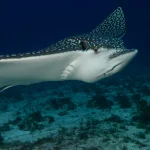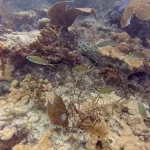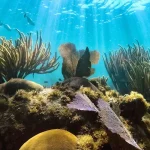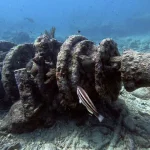Table of Contents

The Danny McCauley Memorial Reef appears to be a popular and promising dive site, offering a mix of marine life, historical interest, and ongoing ecological development. However, there are also concerns about preserving the reef’s ecosystem for long-term enjoyment and environmental benefit.
Article at a Glance
- Historical Significance: The Danny McCauley Memorial Reef is an artificial reef created from the M/V Pocahontas, a World War II vintage tugboat built in 1944, which now serves as a memorial.
- Sinking and Location: The tugboat was intentionally sunk on February 22, 2013, less than two miles northeast of Lake Worth Inlet in Palm Beach County, Florida, at a depth of 74 feet.
- Memorial Tribute: Named in honor of Danny McCauley, a passionate young diver and fisherman who tragically lost his life in a car accident in 2012, the reef serves as a lasting tribute to his memory.
- Diving Experience: The wreck offers varied depths for divers, with the deck located around 50 feet, making it accessible for divers of different skill levels.
- Marine Ecosystem: Since its sinking, the reef has rapidly developed into a thriving marine habitat, attracting diverse species, including goliath groupers and barracudas, as well as various tropical fish.
- Community Involvement: The creation of the reef was a collaborative effort involving Danny’s family, local environmental management, and diving associations, highlighting community engagement in marine conservation.
- Diving Accessibility: Numerous dive shops, such as Stuart Scuba and Pura Vida Divers, offer trips to the wreck, making it a popular destination for scuba enthusiasts in the region.
Shipwreck Location Coordinates and Depth
Depth
The wreck sits at the following depths:
- Maximum depth: 76 feet (23 meters)
- The tugboat rests in 74 feet of seawater
- The deck is in the 50-foot range
Location Coordinates
- Less than two miles northeast of Lake Worth Inlet in Palm Beach County, Florida
- At coordinates 26° 47.60′ N, 80° 01.10′ W
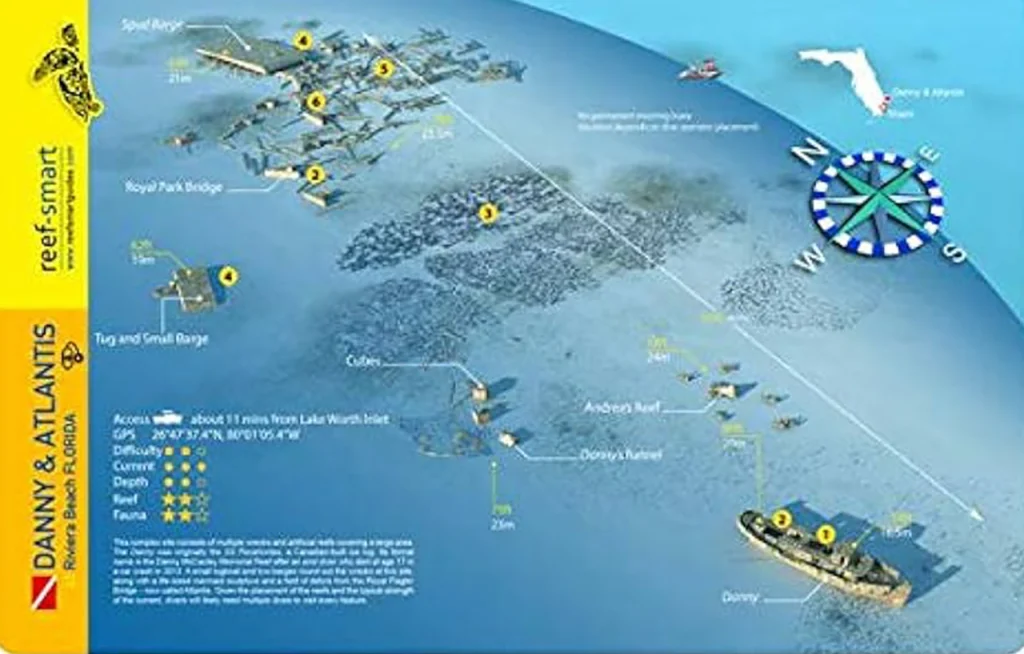
What Do Scuba Divers Say About This Ship
Positive Aspects
- Marine Life: Divers report seeing an abundance of marine life, both large and small, that have settled around the wreck. Specific sightings include:
- Goliath groupers, especially during their spawning aggregation in late August and early September
- Barracudas
- Various tropical fish species
- Rapid Growth: Despite being a relatively new artificial reef, divers note that marine growth is already visible and progressing quickly. They observe:
- A sheet of algae and encrusting sponges covering most of the metal
- Expectations for colorful colonies of sponges to develop over time
- Diving Conditions: The wreck offers varied diving depths, with the tugboat sitting in 74 feet of seawater and the deck in the 50-foot range. This allows divers to explore different parts of the structure at various depths.
- Historical Interest: As a World War II vintage tugboat built in 1944, the wreck holds historical significance that may appeal to divers interested in maritime history.
Challenges and Concerns
- Spearfishing Impact: Some divers have expressed concern about the impact of spearfishing on the reef’s ecosystem. There are reports of barracudas being systematically killed for commercial sale, potentially disrupting the natural balance of the reef.
- Conservation Efforts: Divers and boat operators have called for regulations to protect the marine life around the wreck, such as establishing no-kill zones and restricting the use of underwater propulsion vehicles for spearfishing.
What Kind of Marine Life Can Be Found on The Ship
Fish Species
- Goliath Groupers: These large fish are frequently spotted, especially during their spawning aggregation in late August and early September.
- Barracudas: These predatory fish are common inhabitants of the wreck, often seen swimming in the area.
- Tropical Fish: A diverse array of smaller tropical fish species have made the wreck their home.
Sharks
Caribbean reef sharks have been observed in the vicinity of the wreck, particularly near the nearby bridge tender debris.
Marine Growth
The wreck is rapidly developing as an artificial reef, with various forms of marine life attaching to its structure:
- Algae: A sheet of algae covers most of the metal surfaces of the wreck.
- Encrusting Sponges: These are among the first organisms to colonize the wreck’s surfaces.
- Colorful Sponge Colonies: While still in the early stages, divers anticipate the development of vibrant sponge colonies similar to those seen on other nearby artificial reefs.
Overall Ecosystem Development
Despite being a relatively new artificial reef (sunk in February 2013), the Danny McCauley Memorial Reef has shown rapid colonization by marine life. The abundance of both large and small marine organisms suggests that the wreck is successfully fulfilling its role as an artificial reef, providing habitat and attracting a diverse range of species.
Key Information
| Aspect | Details |
|---|---|
| Name | Danny McCauley Memorial Reef |
| Original Ship Name | Pocahontas |
| Type of Vessel | World War II tugboat |
| Year Built | 1944 |
| Place Built | Canada |
| Length | 110 feet |
| Width | 25 feet |
| Sinking Date | February 22, 2013 |
| Location | Atlantic Ocean off Palm Beach, Florida |
| Depth | 74 feet of water |
| Orientation | Upright, bow facing south |
| Funding | $10,000 from McCauley family, $25,000 from Palm Beach County |
| Purpose | Artificial reef and memorial |
| Previous Status | Derelict in Miami River for 35 years |
| Memorial For | Danny McCauley, 17-year-old who died in a car accident on February 22, 2012 |
| Diving Conditions | Part of Gulf Stream, potential for drift diving |
| Marine Life | Developing ecosystem with corals, sponges, and fish |
| Visitor Numbers | Thousands of divers annually |
What Makes The Danny McCauley Memorial Reef Shipwreck a Unique Diving Experience
Historical Significance
- World War II vintage tugboat built in 1944 in Ontario, Canada
- Originally named M/V Pocahontas, now serving as an artificial reef and memorial
Location and Depth
- Sits less than two miles northeast of Lake Worth Inlet in Palm Beach County, Florida
- Rests in 74 feet of seawater, with the deck at around 50 feet depth
- Provides varied diving depths for different skill levels
Marine Life Development
- Rapidly developing as an artificial reef since its sinking in 2013
- Attracts diverse marine life, including:
- Goliath groupers, especially during spawning season in late August/early September
- Barracudas
- Various tropical fish species
Ecosystem Connectivity
- Acts as a “stepping stone” between older reef placements to the south and Royal Park Bridge materials to the north
- Part of a larger network of artificial reefs in the area, enhancing overall marine biodiversity
Memorial Aspect
- Named in honor of Danny McCauley, a young diver and fisherman who tragically passed away
- Represents a community effort to create a lasting tribute and enhance marine habitat
Diving Conditions
- Often experiences good visibility
- Can offer drift diving opportunities due to Gulf Stream currents
How Does The Danny McCauley Memorial Reef Compare to Other Shipwrecks in Florida
Age and Historical Significance
- The Danny McCauley Memorial Reef is a relatively new artificial reef, sunk in 2013
- Many other Florida shipwrecks are much older, dating back centuries:
- The Emanuel Point Wreck from 1559
- The Atocha and Santa Margarita from 1622
- The Nuestra Espana fleet from 1733
Origin and Purpose
- The Danny was intentionally sunk as an artificial reef and memorial
- Many historic Florida wrecks were the result of accidents, hurricanes, or warfare:
- The Emanuel Point Wreck was lost in a hurricane during a colonization attempt
- The Atocha and Santa Margarita were treasure ships lost in a hurricane
- Numerous ships were sunk by German U-boats during WWII off Florida’s coast
Depth and Accessibility
- The Danny rests in 74 feet of water, with its deck at around 50 feet
- Other wrecks vary greatly in depth:
- Some, like the San Pedro from the 1733 fleet, are in shallower waters and more accessible
- Others, like the recently discovered 200-year-old wreck, lie in much deeper waters (4,000 feet)
Marine Life and Ecosystem
- The Danny is rapidly developing as an artificial reef, attracting various marine species
- Older wrecks often have more established ecosystems:
- The San Pedro, for example, is described as one of Florida’s oldest artificial reefs with abundant marine life
Treasure and Artifacts
- The Danny doesn’t contain historical treasures or artifacts
- Many historic Florida wrecks were treasure ships or contained valuable cargo:
- The Atocha and Santa Margarita carried significant amounts of gold, silver, and jewels
- The 1733 fleet wrecks contained various valuable goods
Diving Experience
- The Danny offers a modern wreck diving experience with good visibility and varied depths
- Historic wrecks often provide a more archaeological diving experience, with the potential to see centuries-old artifacts and structures
What is The Full History of This Ship
Original Identity and Construction
- Originally named M/V Pocahontas
- Built in Ontario, Canada in 1944
- A World War II vintage tugboat, 110 feet long and 25 feet wide
Service History
- Served as a tugboat during and after World War II
- Specific details of its service are not provided in the search results
Derelict Period
- Spent 35 years as a derelict vessel in the Miami River
Transformation into an Artificial Reef
- Selected for the Palm Beach County artificial reef program
- Renamed as the Danny McCauley Memorial Reef
- Acquisition and preparation:
- Danny McCauley’s family raised $10,000
- Palm Beach County contributed an additional $25,000
- Funds used to obtain, clean, and convert the ship for sinking
Sinking and Memorial
- Sunk on February 22, 2013
- Date coincidentally matched the one-year anniversary of Danny McCauley’s passing
- Location: Less than two miles northeast of Lake Worth Inlet, Palm Beach County, Florida
- Depth: Rests in 74 feet of water, with the deck at around 50 feet
Purpose and Significance
- Created as a memorial for Danny McCauley, a 17-year-old avid fisherman and diver who died in a car accident in 2012
- Part of Palm Beach County’s artificial reef program
- Serves as a “stepping stone” between older reef placements to the south and Royal Park Bridge materials to the north
- Provides habitat for marine life and a new dive site for scuba enthusiasts
Current Status
- Rapidly developing as an artificial reef
- Attracting diverse marine life, including goliath groupers, barracudas, and various tropical fish species
- Popular dive site, drawing thousands of divers annually
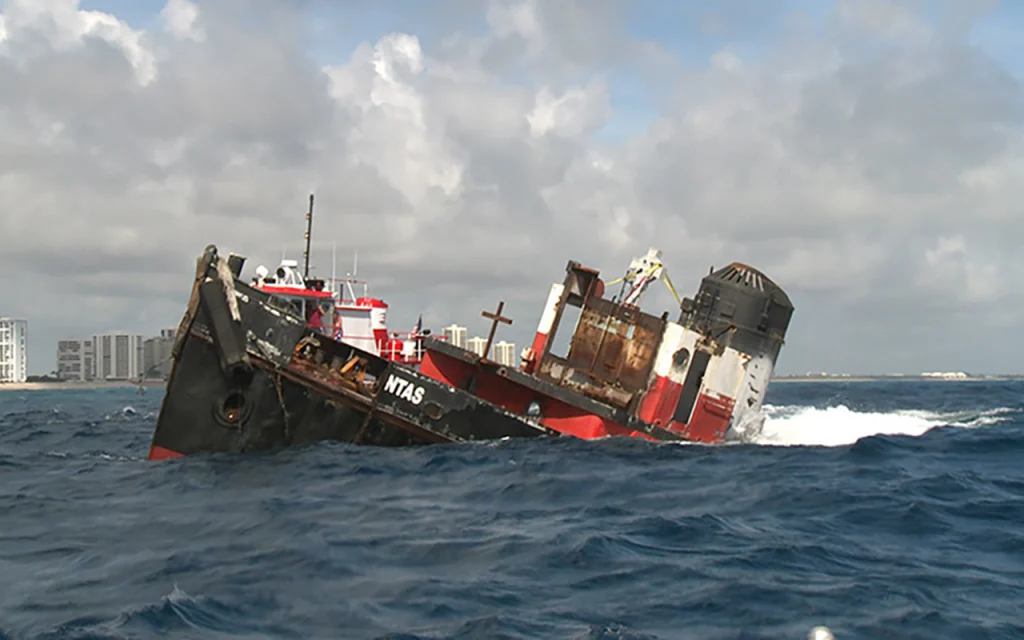
What Historical Features Can Still Be Identified on the Danny McCauley Memorial Reef Wreck
- Overall Structure: The wreck is a 110-foot long World War II vintage tugboat, so divers should be able to recognize the general tugboat shape and layout.
- Deck: The deck of the tugboat is mentioned to be in the 50-foot depth range, making it a prominent feature for divers to explore.
- Bow: The search results mention that the tugboat sits upright on the bottom with its bow facing south, so the bow structure should be identifiable3.
- Hull: As a former tugboat, the hull design characteristic of these vessels should still be apparent.
- Superstructure: While not explicitly mentioned, typical tugboat features like the wheelhouse or bridge area may still be recognizable, depending on the state of preservation.
What Safety Measures Are in Place for Divers Visiting the Danny McCauley Memorial Reef
- Depth Range: The wreck sits in 74 feet of seawater, with the deck in the 50-foot range. This depth range allows for varied diving experiences but requires appropriate dive planning and skills.
- Dive Flags: It’s mandatory for boats to display dive flags when divers are underwater in Florida. This helps alert other vessels to the presence of divers.
- Guided Dives: Many dive operators, like Stuart Scuba and Pura Vida Divers, offer guided trips to the site. These professionally led dives can enhance safety through proper briefings and supervision.
- Nitrox Recommendation: For the wreck dives in this area, nitrox is strongly recommended, though not required. This can help extend bottom time and provide an added safety margin.
- Dive Planning: The depths involved (70-90 feet) necessitate careful dive planning, including proper gas management and decompression considerations.
- Current Awareness: The area is known for Gulf Stream currents, which can vary in strength and direction. Divers need to be prepared for potential drift diving conditions.
- Marine Life Awareness: While not a direct safety measure, divers should be aware of the marine life present, including large species like goliath groupers, to avoid any negative interactions.
- Pre-Dive Briefings: Dive operators typically provide briefings before the dive to familiarize divers with the site, potential hazards, and emergency procedures.
Dive Shops That Provide Diving Trips to This Shipwreck
- Stuart Scuba
- Offers scheduled wreck dives to the Danny McCauley Memorial Reef
- Provides detailed information about the wreck and its history
- Price for a dive trip: $83.06 (as of the date mentioned in the search results)
- Pura Vida Divers
- Conducts 2-tank wreck dives that include the Danny McCauley Memorial Reef
- Offers trips on their boat named Sirena
- Provides both morning (8:30 AM) and afternoon (1:30 PM) dive options
- Strongly recommends the use of Nitrox for these dives
South Florida Wrecks
- SS Copenhagen
- Captain Dan Wreck
- SS Arratoon
- Queen of Nassau
- USS Mohawk
- MV Castor
- Esso Bonaire III
- St. Jacques
- The Gilbert Sea
- Shasha Boekanier
- Thozina
- The Orion
- The DEMA Trader
- Ancient Mariner
- The Amaryllis
- The Ande
- USS Hydro Atlantic
- Zion Train
- Mercedes I
- Half Moon
- The Danny
- The Ultra Freeze
- The Doc DeMilly
- Jay Scutti
- The Tracy
- Sea Emperor
- Jim Atria
- Merci Jesus
- Princess Britney


